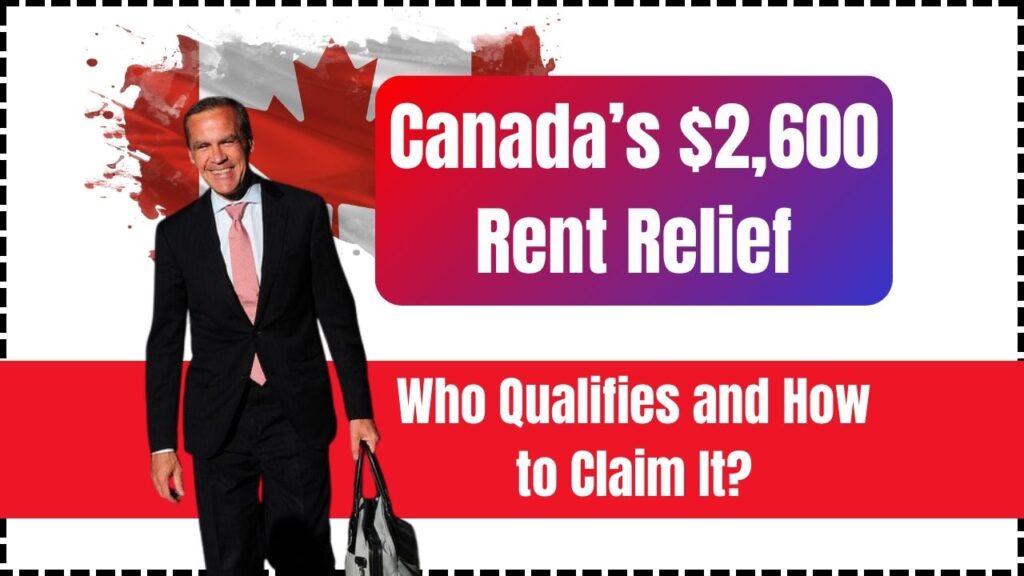
Canada’s $2,600 Rent Relief in 2025: In 2025, Canada’s $2,600 Rent Relief has been making headlines as renters across the country seek financial assistance in the face of rising living costs. However, it’s important to clarify that while a $2,600 lump-sum payment is not currently offered by the federal government, several combined housing benefits can total up to (or even exceed) $2,600 annually for eligible Canadians. This guide will walk you through who qualifies, how to apply, and what practical steps you can take to benefit from Canada’s latest rent relief programs.
Canada’s $2,600 Rent Relief in 2025
While Canada’s $2,600 Rent Relief in 2025 isn’t a single payment, renters can access significant financial support by tapping into a range of federal and provincial programs. If you meet the eligibility criteria and follow the application process correctly, you could secure meaningful assistance to help cover your rental costs. Staying informed, proactive, and organized will be key to maximizing your benefits.
| Program | Benefit Amount | Eligibility | Application Method |
|---|---|---|---|
| Canada Housing Benefit (CHB) | $500 (one-time) | Individuals earning ≤$20,000; Families earning ≤$35,000 | Apply through CRA My Account or by phone |
| Canada-Ontario Housing Benefit (COHB) | Varies, monthly assistance | Households on social housing waitlists | Referral through local service managers |
| Canada-BC Housing Benefit (CBCHB) | Varies | Households paying >30% of income on rent | Invitation-based |
| Quebec Shelter Allowance Program | Up to $80/month | Older adults or families with dependents, meeting income criteria | Application through Revenu Québec |
| Canada Rental Protection Fund | N/A (indirect aid) | Community housing providers maintaining affordability | Application by organizations |
What is Canada’s $2,600 Rent Relief About?
While some media reports and online sources have mentioned a “Canada $2,600 rent stimulus,” the actual support comes from several programs combined. If a renter qualifies for multiple benefits such as the Canada Housing Benefit, a provincial rent supplement, and other supports, they could receive up to or more than $2,600 in total aid throughout 2025.
In fact, Canada’s overall housing relief strategy in 2025 emphasizes both short-term financial support and long-term affordable housing investments, such as the Canada Rental Protection Fund, which preserves affordable units for low-income Canadians.
Federal Programs: Detailed Overview
Canada Housing Benefit (CHB) – $500 One-Time Payment
Who qualifies?
- Renters who are Canadian citizens, permanent residents, or protected persons.
- Income:
- Individuals: $20,000 or less.
- Families: $35,000 or less.
- Rent must account for at least 30% of household income.
- Must have filed the 2023 tax return.
How to apply?
- Log in to your CRA My Account.
- Navigate to “Apply for Benefits” and choose “Canada Housing Benefit.”
- Fill in your rental payment information and landlord details.
- Submit and monitor your application status.
Important Tip: Ensure your banking details are up-to-date to receive direct deposit faster.
Provincial Rent Assistance: Province-by-Province Breakdown
Ontario: Canada-Ontario Housing Benefit (COHB)
Ontario offers portable housing benefits where eligible renters receive monthly payments directly to help with private-market rents. Recipients do not have to stay in subsidized housing to qualify.
How to apply: You must be referred by a service manager or community agency.
British Columbia: Canada-BC Housing Benefit (CBCHB)
British Columbia provides tailored rent supports for households facing housing insecurity. Priority is given to:
- Seniors
- Indigenous peoples
- Women fleeing violence
- Persons with disabilities
Applications are invitation-only, managed by BC Housing and nonprofit agencies.
Quebec: Shelter Allowance Program
This program supports renters (or homeowners) aged 50 and above or families with dependents. Maximum monthly aid reaches $80, potentially amounting to $960 annually
How Much Could You Actually Get?
Let’s break it down with a real-world example:
Scenario:
- A single renter in Toronto earns $18,000 annually.
- Pays $750/month for rent ($9,000 annually).
Eligibility:
- Canada Housing Benefit: $500 one-time.
- Canada-Ontario Housing Benefit: $200/month ($2,400/year).
- Local municipal housing grant: $300 one-time.
Total Rent Relief in 2025:
$500 + $2,400 + $300 = $3,200
This means that under various programs combined, a renter could receive much more than $2,600 per year.
Step-by-Step Guide: How to Claim Canada’s $2,600 Rent Relief in 2025
- Check Eligibility: Review your income and rent expenses based on program criteria.
- File Taxes: Ensure your 2023 tax return is complete — it’s required for almost all housing benefits.
- Gather Documentation: Prepare lease agreements, rental receipts, proof of payment, and landlord contact information.
- Apply Early: Access CRA portals or provincial housing portals as soon as applications open.
- Monitor Communications: Check emails and CRA accounts regularly for status updates.
- Stay Updated: Policy updates happen quickly.
Canada TFWP Reform: Stricter LMIA Rules & Job Categories Changing in 2025!
Get $500 from Canada’s Housing Benefit in 2025 – Check Eligibility Criteria!
Canada’s $4,100 CRA Payment for May 2025 – Eligibility, Payment Date, and Fact Check
Frequently Asked Questions (FAQs)
Is the $2,600 Rent Relief real?
Not exactly. There’s no singular $2,600 cheque; however, multiple combined benefits can add up to or exceed $2,600 annually depending on your province, income, and situation.
Can newcomers or international students apply?
Most federal rent reliefs are reserved for Canadian citizens, permanent residents, and protected persons. International students typically do not qualify unless they achieve residency status.
How soon will I get the $500 Canada Housing Benefit?
If approved, CRA deposits the funds within 5–7 business days for direct deposits and 10–12 business days by cheque.
Can I qualify for both federal and provincial programs?
Yes! You are encouraged to apply for all programs for which you meet eligibility requirements.








